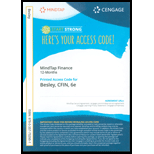
Concept explainers
(a)
Introduction:
Treasury bonds (T-bonds):
These bonds involve earning periodic interest up to maturity (greater than 20 years) and consider government debt securities that are issued by the Federal government of the country.
Expectations theory:
Based on long-term (current) interest rates this theory
To determine: The expected one-year interest rates in the second year by using the expectation theory when the interest rate on one-year treasury bonds is 0.4%, 0.8% on two-year bonds, and 1.1% on three-year T-bonds.
(b)
Introduction:
Treasury bonds (T-bonds):
These bonds involve earning periodic interest up to maturity (greater than 20 years) and consider government debt securities that are issued by the Federal government of the country.
Expectations theory:
Based on long-term (current) interest rates this theory forecasts the short-term interest rates for the future where an investor receives the same amount of interest by investing in two (one-year bond and two-year bond), one after the other year. It is useful to calculate the expected returns and differentiate the investment returns in business.
To determine: The expected one-year interest rates in the third year by using the expectation theory when the interest rate on one-year treasury bonds is 1%, 0.9% on two-year bonds, and 0.8% on three-year T-bonds.
Want to see the full answer?
Check out a sample textbook solution
Chapter 5 Solutions
CFIN -STUDENT EDITION-ACCESS >CUSTOM<
- Calculate dividends qnarrow_forwardMr dev.arrow_forwardWhich of the following is not true about goodwill?* Goodwill needs to be evaluated for impairment yearly Goodwill is treated as a tangible asset in accounting Goodwill is a result of purchasing a company for a price higher than the fair market value of the target company's net assets Goodwill can be comprised of things such as good reputation, loyal client base, and brand recognitionarrow_forward
